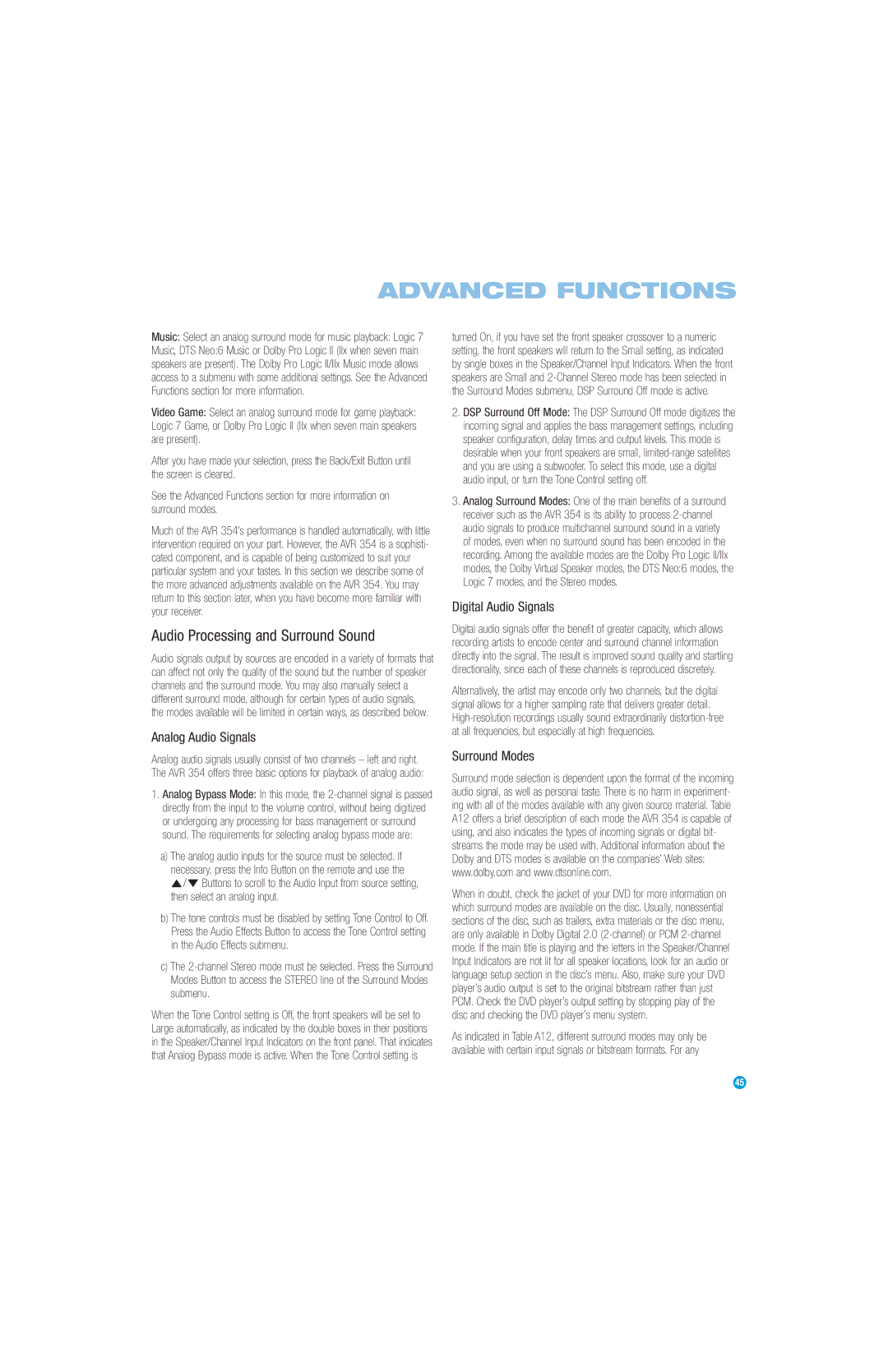ADVANCED FUNCTIONS
Music: Select an analog surround mode for music playback: Logic 7 Music, DTS Neo:6 Music or Dolby Pro Logic II (IIx when seven main speakers are present). The Dolby Pro Logic II/IIx Music mode allows access to a submenu with some additional settings. See the Advanced Functions section for more information.
Video Game: Select an analog surround mode for game playback: Logic 7 Game, or Dolby Pro Logic II (IIx when seven main speakers are present).
After you have made your selection, press the Back/Exit Button until the screen is cleared.
See the Advanced Functions section for more information on surround modes.
Much of the AVR 354’s performance is handled automatically, with little intervention required on your part. However, the AVR 354 is a sophisti- cated component, and is capable of being customized to suit your particular system and your tastes. In this section we describe some of the more advanced adjustments available on the AVR 354. You may return to this section later, when you have become more familiar with your receiver.
Audio Processing and Surround Sound
Audio signals output by sources are encoded in a variety of formats that can affect not only the quality of the sound but the number of speaker channels and the surround mode. You may also manually select a different surround mode, although for certain types of audio signals, the modes available will be limited in certain ways, as described below.
Analog Audio Signals
Analog audio signals usually consist of two channels – left and right. The AVR 354 offers three basic options for playback of analog audio:
1.Analog Bypass Mode: In this mode, the
a)The analog audio inputs for the source must be selected. If necessary, press the Info Button on the remote and use the ⁄ /¤ Buttons to scroll to the Audio Input from source setting, then select an analog input.
b)The tone controls must be disabled by setting Tone Control to Off. Press the Audio Effects Button to access the Tone Control setting in the Audio Effects submenu.
c)The
When the Tone Control setting is Off, the front speakers will be set to Large automatically, as indicated by the double boxes in their positions in the Speaker/Channel Input Indicators on the front panel. That indicates that Analog Bypass mode is active. When the Tone Control setting is
turned On, if you have set the front speaker crossover to a numeric setting, the front speakers will return to the Small setting, as indicated by single boxes in the Speaker/Channel Input Indicators. When the front speakers are Small and
2.DSP Surround Off Mode: The DSP Surround Off mode digitizes the incoming signal and applies the bass management settings, including speaker configuration, delay times and output levels. This mode is desirable when your front speakers are small,
3.Analog Surround Modes: One of the main benefits of a surround receiver such as the AVR 354 is its ability to process
Digital Audio Signals
Digital audio signals offer the benefit of greater capacity, which allows recording artists to encode center and surround channel information directly into the signal. The result is improved sound quality and startling directionality, since each of these channels is reproduced discretely.
Alternatively, the artist may encode only two channels, but the digital signal allows for a higher sampling rate that delivers greater detail.
Surround Modes
Surround mode selection is dependent upon the format of the incoming audio signal, as well as personal taste. There is no harm in experiment- ing with all of the modes available with any given source material. Table A12 offers a brief description of each mode the AVR 354 is capable of using, and also indicates the types of incoming signals or digital bit- streams the mode may be used with. Additional information about the Dolby and DTS modes is available on the companies’ Web sites: www.dolby.com and www.dtsonline.com.
When in doubt, check the jacket of your DVD for more information on which surround modes are available on the disc. Usually, nonessential sections of the disc, such as trailers, extra materials or the disc menu, are only available in Dolby Digital 2.0
As indicated in Table A12, different surround modes may only be available with certain input signals or bitstream formats. For any
45
